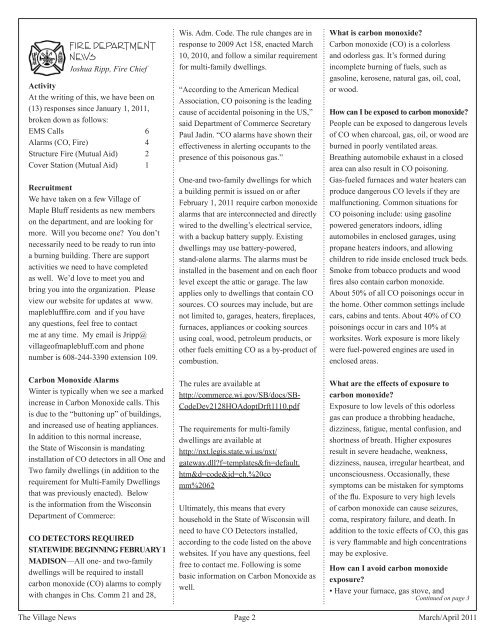2011 - Village of Maple Bluff
2011 - Village of Maple Bluff
2011 - Village of Maple Bluff
You also want an ePaper? Increase the reach of your titles
YUMPU automatically turns print PDFs into web optimized ePapers that Google loves.
FIRE DEPARTMENT<br />
NEWS<br />
Joshua Ripp, Fire Chief<br />
Activity<br />
At the writing <strong>of</strong> this, we have been on<br />
(13) responses since January 1, <strong>2011</strong>,<br />
broken down as follows:<br />
EMS Calls 6<br />
Alarms (CO, Fire) 4<br />
Structure Fire (Mutual Aid) 2<br />
Cover Station (Mutual Aid) 1<br />
Recruitment<br />
We have taken on a few <strong>Village</strong> <strong>of</strong><br />
<strong>Maple</strong> <strong>Bluff</strong> residents as new members<br />
on the department, and are looking for<br />
more. Will you become one? You don’t<br />
necessarily need to be ready to run into<br />
a burning building. There are support<br />
activities we need to have completed<br />
as well. We’d love to meet you and<br />
bring you into the organization. Please<br />
view our website for updates at www.<br />
mapleblufffire.com and if you have<br />
any questions, feel free to contact<br />
me at any time. My email is Jripp@<br />
village<strong>of</strong>maplebluff.com and phone<br />
number is 608-244-3390 extension 109.<br />
Carbon Monoxide Alarms<br />
Winter is typically when we see a marked<br />
increase in Carbon Monoxide calls. This<br />
is due to the “buttoning up” <strong>of</strong> buildings,<br />
and increased use <strong>of</strong> heating appliances.<br />
In addition to this normal increase,<br />
the State <strong>of</strong> Wisconsin is mandating<br />
installation <strong>of</strong> CO detectors in all One and<br />
Two family dwellings (in addition to the<br />
requirement for Multi-Family Dwellings<br />
that was previously enacted). Below<br />
is the information from the Wisconsin<br />
Department <strong>of</strong> Commerce:<br />
CO DETECTORS REQUIRED<br />
STATEWIDE BEGINNING FEBRUARY 1<br />
MADISON—All one- and two-family<br />
dwellings will be required to install<br />
carbon monoxide (CO) alarms to comply<br />
with changes in Chs. Comm 21 and 28,<br />
Wis. Adm. Code. The rule changes are in<br />
response to 2009 Act 158, enacted March<br />
10, 2010, and follow a similar requirement<br />
for multi-family dwellings.<br />
“According to the American Medical<br />
Association, CO poisoning is the leading<br />
cause <strong>of</strong> accidental poisoning in the US,”<br />
said Department <strong>of</strong> Commerce Secretary<br />
Paul Jadin. “CO alarms have shown their<br />
effectiveness in alerting occupants to the<br />
presence <strong>of</strong> this poisonous gas.”<br />
One-and two-family dwellings for which<br />
a building permit is issued on or after<br />
February 1, <strong>2011</strong> require carbon monoxide<br />
alarms that are interconnected and directly<br />
wired to the dwelling’s electrical service,<br />
with a backup battery supply. Existing<br />
dwellings may use battery-powered,<br />
stand-alone alarms. The alarms must be<br />
installed in the basement and on each floor<br />
level except the attic or garage. The law<br />
applies only to dwellings that contain CO<br />
sources. CO sources may include, but are<br />
not limited to, garages, heaters, fireplaces,<br />
furnaces, appliances or cooking sources<br />
using coal, wood, petroleum products, or<br />
other fuels emitting CO as a by-product <strong>of</strong><br />
combustion.<br />
The rules are available at<br />
http://commerce.wi.gov/SB/docs/SB-<br />
CodeDev2128HOAdoptDrft1110.pdf<br />
The requirements for multi-family<br />
dwellings are available at<br />
http://nxt.legis.state.wi.us/nxt/<br />
gateway.dll?f=templates&fn=default.<br />
htm&d=code&jd=ch.%20co<br />
mm%2062<br />
Ultimately, this means that every<br />
household in the State <strong>of</strong> Wisconsin will<br />
need to have CO Detectors installed,<br />
according to the code listed on the above<br />
websites. If you have any questions, feel<br />
free to contact me. Following is some<br />
basic information on Carbon Monoxide as<br />
well.<br />
What is carbon monoxide?<br />
Carbon monoxide (CO) is a colorless<br />
and odorless gas. It’s formed during<br />
incomplete burning <strong>of</strong> fuels, such as<br />
gasoline, kerosene, natural gas, oil, coal,<br />
or wood.<br />
How can I be exposed to carbon monoxide?<br />
People can be exposed to dangerous levels<br />
<strong>of</strong> CO when charcoal, gas, oil, or wood are<br />
burned in poorly ventilated areas.<br />
Breathing automobile exhaust in a closed<br />
area can also result in CO poisoning.<br />
Gas-fueled furnaces and water heaters can<br />
produce dangerous CO levels if they are<br />
malfunctioning. Common situations for<br />
CO poisoning include: using gasoline<br />
powered generators indoors, idling<br />
automobiles in enclosed garages, using<br />
propane heaters indoors, and allowing<br />
children to ride inside enclosed truck beds.<br />
Smoke from tobacco products and wood<br />
fires also contain carbon monoxide.<br />
About 50% <strong>of</strong> all CO poisonings occur in<br />
the home. Other common settings include<br />
cars, cabins and tents. About 40% <strong>of</strong> CO<br />
poisonings occur in cars and 10% at<br />
worksites. Work exposure is more likely<br />
were fuel-powered engines are used in<br />
enclosed areas.<br />
What are the effects <strong>of</strong> exposure to<br />
carbon monoxide?<br />
Exposure to low levels <strong>of</strong> this odorless<br />
gas can produce a throbbing headache,<br />
dizziness, fatigue, mental confusion, and<br />
shortness <strong>of</strong> breath. Higher exposures<br />
result in severe headache, weakness,<br />
dizziness, nausea, irregular heartbeat, and<br />
unconsciousness. Occasionally, these<br />
symptoms can be mistaken for symptoms<br />
<strong>of</strong> the flu. Exposure to very high levels<br />
<strong>of</strong> carbon monoxide can cause seizures,<br />
coma, respiratory failure, and death. In<br />
addition to the toxic effects <strong>of</strong> CO, this gas<br />
is very flammable and high concentrations<br />
may be explosive.<br />
How can I avoid carbon monoxide<br />
exposure?<br />
• Have your furnace, gas stove, and<br />
Continued on page 3<br />
The <strong>Village</strong> News Page 2 March/April <strong>2011</strong>







